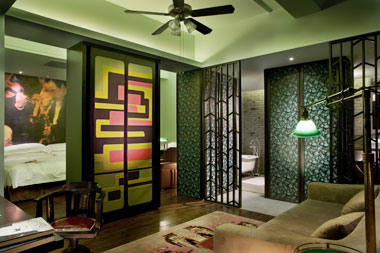|

|
|
The art deco Grand Room and lobby of @Gallery Suites on Hengshan Road in Shanghai. [Shanghai Daily]
|
The distinctiveness of old buildings makes them perfect for boutique hotels - the designer labels of the industry. But conversion is a tricky business requiring just the right balance of the old and the new, preservation and commerce.
Converted hotels are a very welcome addition to Shanghai's architectural landscape, says Anne Warr, author of "Shanghai Architecture" and the China director of AJ+C Architecture Consulting.
"They retain an element of Shanghai's historic landscape and make them accessible, so we can all enjoy the buildings," says Warr.
But successful conversions require a careful balance of old and new elements. "It's important for the new architect to respect the spirit of the original architect's intentions, without copying or imitating it. It rarely works well, replicating or copying old details, but a well-executed contrast between the old and new can be very exciting."
Opening later this month, the @Gallery Suites on Hengshan Road is a good example of renovations that respect original details.
It is located in the municipally protected Cavendish Court building. Built in 1934, its style is a simpler, more modern version of the art deco trends of the time.
Internally the new hotel has a simple, low-key, art deco theme that blends well with the original style. The lobby of marble and dark oak is understatedly chic. The hotel is also well served by being entirely non-smoking.
The 40 rooms are more luxurious, with modern contrasts like paintings by upcoming artists adorning the walls and setting the mood. Respecting the original apartment layout of the building, they are some of the largest hotel rooms around.
The hotel aims to give even business travelers a sense of place, says Lenny Wong, managing director of Singapore-based CTC Tourism Holdings. Four Shanghai-based Hong Kong architects designed the hotel.
"We wanted designers who had lived in Shanghai, with an understanding of China but also international exposure," Wong says.
In Jing'an District a more jarring conversion can be found at the Garden Mansion Hotel. Due to open in late July, this development had an interesting architectural starting point as Pei House (also a protected building). Built in 1934 by I.M. Pei's uncle, this garden villa combines Chinese and Western styles, reflecting the overseas educated Pei family.
Highlights include an ornate, blue-gray marble staircase carved in the shape of a spiraling dragon, and a domed dragon ceiling in one of the rooms.
But the new hotel has gone for a rough and ready concept of old Shanghai that has overwhelmed the character of the building. Imitations of 1930s furniture fill the rooms, and a palpable sense of newness hits you on entering the building. Most of the dragon staircase has been covered by beige wallpaper to "match the carpet," a Garden Mansion Hotel representative says.
Their earlier property, the Mansion Hotel on Xinle Road, had more than 300 items of original 1930s antiques, including gramophones and film reels. Eventually the new Garden Mansion Hotel will also have antique artifacts, which will increase authenticity.
The size and layout of the old rooms are very appealing, and with only 25 rooms there's plenty of space for ornate lobbies and restaurants. If done well, the rooftop bar could also be a cool new addition this summer. But the best thing about this hotel remains the gardens and exterior which by law cannot be changed.
"In my opinion, we should preserve good quality, original details, and add new contemporary work that respects the old. Then the distinction between old and new is very clear," says Warr.
The bold new Waterhouse development in the south Bund area takes this approach.
New Singaporean owner, Cameron Holdings, is converting a dockside warehouse that belonged to a 1930s Japanese company into a 19-room hotel. The hotel will open at the end of the year but a function space is up and running.
According to designer Lyndon Neri, founder of Neri & Hu, this hotel is designed for "travelers" who want to understand the city, rather than "tourists" who just want to see the sights.
With a completely new take on Shanghai longtang (lane) living, Neri explores how public and private spaces can be blurred, just as life is very crowded and public in lane houses.
"I see people putting tables onto the sidewalk, and the entire family eating their dinner there. The road becomes their dining room," says Neri. "This middle ground makes the city tick. It's dangerous for society to completely separate public and private - then people can do anything in private."
So here a public restaurant will offer glimpses into private bedrooms. Rooms will have louvers opening onto the public courtyard. Made of mirrors, these louvers will let guests "spy" on the public areas and other rooms. The functions space even comes with a "peek-a-boo" toilet.
But the contemporary approach can also have pitfalls. "It's merely decorative to just put something new into an old building," says Neri. "Respecting the space is about proper abstraction and reinterpretation of the feel and essence of the city."
@Gallery Suites
Address: 525 Hengshan Rd
Prices: 1,500-5,000 yuan
Tel: 5179-5000
Garden Mansions
Address: 170 Nanyang Rd
Prices: 2,888-6,688 yuan (plus 15-percent service charge)
Tel: 5403-9888
The Waterhouse
Address: 1 Maojiayuan Rd
Prices: To be confirmed.
Tel: 137-6478-9692 (Nancy Chow)
(Shanghai Daily June 9, 2009)